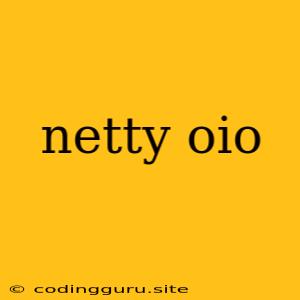Netty: Understanding the OIO and NIO Models
Netty is a powerful and versatile Java network framework that simplifies the development of high-performance network applications. One of the key concepts in Netty is the difference between OIO (Old I/O) and NIO (New I/O) models. Choosing the right model is crucial for achieving optimal performance and scalability in your applications.
What is OIO?
OIO (Old I/O), also known as blocking I/O, is the traditional way of handling network operations in Java. In this model, a single thread is dedicated to handling each connection. When a thread encounters a blocking operation like reading or writing data, it will halt execution until the operation completes. This can be inefficient, especially when dealing with multiple concurrent connections. Imagine a single cashier handling multiple customers - they can only serve one customer at a time, and must wait for each customer's transaction to finish before moving on to the next.
What is NIO?
NIO (New I/O), introduced in Java 1.4, offers a more efficient and scalable approach to network communication. Unlike OIO, NIO is asynchronous and non-blocking. It allows a single thread to handle multiple connections simultaneously. With NIO, a thread can initiate an I/O operation and continue processing other requests while the operation is in progress. When the operation completes, the thread receives a notification and can then handle the result. This is analogous to having multiple cashiers in a store, allowing customers to be served more efficiently.
Why choose NIO over OIO?
NIO offers significant advantages over OIO:
- Improved Scalability: NIO allows a single thread to handle multiple connections, making it more scalable for applications that need to support a large number of concurrent users.
- Enhanced Performance: NIO's non-blocking nature avoids unnecessary thread blocking, leading to improved performance and faster response times.
- Reduced Resource Consumption: NIO requires fewer threads compared to OIO, minimizing resource consumption and improving overall system efficiency.
How does Netty utilize NIO?
Netty leverages the power of NIO to provide a high-performance network framework. It utilizes NIO channels, selectors, and buffers to manage network connections and data transfer.
- Channels: NIO channels represent the connection between a client and a server. They provide methods for reading and writing data.
- Selectors: Selectors allow a single thread to monitor multiple channels for I/O events, such as data readiness for reading or writing.
- Buffers: NIO buffers are used to store and manipulate data efficiently. They provide methods for reading, writing, and manipulating data in a byte-oriented manner.
When should you consider OIO?
Although NIO offers significant advantages, OIO can still be a valid choice in certain scenarios:
- Simple Applications: If your application involves minimal network traffic and handles a small number of connections, OIO might be sufficient.
- Legacy Codebase: If your application relies heavily on existing OIO code, migrating to NIO might be complex and time-consuming.
Conclusion
Netty provides a powerful framework for building high-performance network applications. Understanding the difference between OIO and NIO is essential for choosing the optimal model for your application. NIO is generally preferred for its scalability, performance, and resource efficiency, especially when handling a large number of concurrent connections. However, OIO can still be a valid option for simple applications with minimal network traffic.
